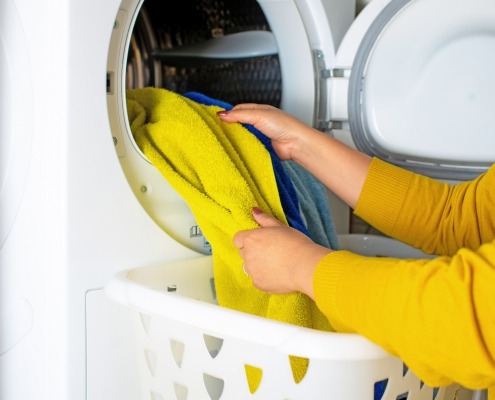Tips for Caring for Your Dryer: Clothes Dryer Maintenance
Steven E / Wednesday August 23, 2023
Importance of dryer efficiency
Taking the time to make sure your clothes dryer runs efficiently can save energy and reduce your utility costs while prolonging the lifespan of the machine. Failing to regularly maintain a dryer can result in a myriad of issues including increased energy consumption, decreased performance, and costly repairs. Follow the tips below on routine cleaning, proper usage, and more so you can get the most out of your dryer while minimizing potential problems.
Regularly clean the lint filter
Cleaning the lint filter is crucial in maintaining your dryer’s efficiency.
The lint filter traps and collects lint, a byproduct of the drying process. The lint, if allowed to accumulate, can obstruct airflow and force your dryer to work harder, consuming more energy in the process. Excessive lint buildup can also become a fire hazard, which can pose a serious risk to your home and family.
The lint filter should be cleaned after every drying cycle to maximize the dryer’s efficiency and minimize the risk of lint-related issues. If you tend to forget to clean the filter, consider setting a reminder or placing a note near your dryer. For households that use the dryer often, the lint filter should be checked and cleaned several times a week.
How to Clean a Lint Filter
- Locate the lint filter: The lint filter sits near the dryer’s door or on the top of the machine. Check your dryer’s manual if you are unsure where it’s located.
- Remove the lint filter: Gently pull the lint filter out of its housing to avoid damaging it.
- Clean the filter: Use your hand or a soft brush to remove the lint from the filter’s surface. Remove as much lint as possible.
- Inspect the filter: Check the filter for any signs of damage or wear. If you notice any tears or holes, replace the filter immediately.
- Vacuum the lint filter housing: Use a vacuum cleaner with a narrow hose attachment to remove any lint that may have settled in the filter housing.
- Reinsert the lint filter: Once you have a clean lint filter and have removed debris from the housing, slide the lint filter back into place.
- Clean the surrounding area: Wipe down the area around the lint filter with a damp cloth to remove any remaining lint or dust.
WATCH: Electric Dryer NOT Drying or Taking Too Long – TOP 7 Reasons & Fixes
Inspect and clean the dryer vent
The dryer vent expels hot, moist air generated during the drying process. Over time, lint and debris can accumulate in the vent, which can obstruct airflow and reduce your dryer’s performance. Clogged vents can lead to longer drying times and strain on the dryer’s other components. A clogged vent can also pose a fire risk since trapped lint can ignite due to the high temperatures inside. Regularly inspecting and maintaining a clean dryer vent is vital for the safe and efficient operation of the entire appliance. Make it a habit to check your dryer vent at least once a month or more often if you use your dryer frequently.
Here are some signs of a clogged or damaged dryer vent:
- Longer drying times: If your clothes take longer than usual to dry or need multiple cycles, it may be due to restricted airflow caused by a clogged vent.
- Overheating: If the dryer or the clothes inside feel hot to the touch, it could be a sign of insufficient ventilation.
- Burning smell: A burning odor coming from the dryer may indicate that lint has accumulated in the vent and is overheating.
- Visible lint accumulation: If you notice lint accumulating around the vent or on the exterior of your home, the vent may be clogged.
- Poor indoor air quality: A clogged vent can cause moisture and lint to be released into your home, which reduces indoor air quality and can trigger allergies.
WATCH: Gas Dryer NOT Drying or Taking Too Long – TOP 7 Reasons & Fixes
Check for proper airflow and ventilation
Efficient airflow helps remove moisture from your clothes more effectively and reduces drying times and energy consumption. Proper ventilation prevents overheating and the build-up of excess moisture in your home, both of which can lead to mold growth.
Balance your dryer load
Overloading or underloading the dryer can have negative impacts on its operation. When the dryer is overloaded, it has to work harder to dry the clothes, which leads to longer drying times and increased energy consumption. Overloaded dryers also tend to wear out faster due to the added strain on their components. On the other hand, underloading the dryer can result in wasted energy and inefficient drying. The dryer uses the same amount of energy regardless of the load size, so be careful with how you load it.
To balance your dryer load, check the manufacturer’s guidelines for capacity and avoid exceeding that limit. As a general rule, aim to fill the dryer drum approximately three-quarters full to help your clothes dry evenly. You can also sort your laundry by fabric type and weight to improve drying efficiency. Lighter fabrics dry faster than heavier ones. By drying similar items together, you can choose the appropriate dryer settings and reduce the risk of over or under-drying your clothes.
For a faster and better drying experience, consider implementing these tips:
- Spin-dry your clothes in the washing machine at a high speed to remove as much excess water as possible before transferring them to the dryer. This will reduce the amount of time and energy needed for drying.
- Use dryer balls or clean, dry towels to help separate clothes and improve airflow within the dryer drum. This can reduce drying time and prevent clothes from clumping together.
- Choose the appropriate dryer settings for your load. Use the moisture sensor setting, if available. The sensor adjusts drying times based on the moisture content of your clothes and can help prevent over-drying and save energy.
Perform routine maintenance and inspections
Performing routine maintenance on your dryer helps you identify and address potential issues before they become significant problems that could result in costly repairs or premature appliance failure. Many maintenance tasks can be performed by homeowners themselves to save money and give them a better understanding of their dryers. When attempting DIY maintenance, be sure to follow the manufacturer’s guidelines and take the proper precautions. You can find many online resources, including tutorials and appliance manuals, to help guide you through the process.
AppliancePartsPros is here to help answer your questions and find the parts you need for your appliances. Be sure to follow us on Facebook and subscribe to our YouTube channel!
With nearly a decade of experience in providing top-notch customer service regarding appliance parts and repair, Steven enjoys sharing practical advice, troubleshooting tips, and interesting information to help readers stay informed.





